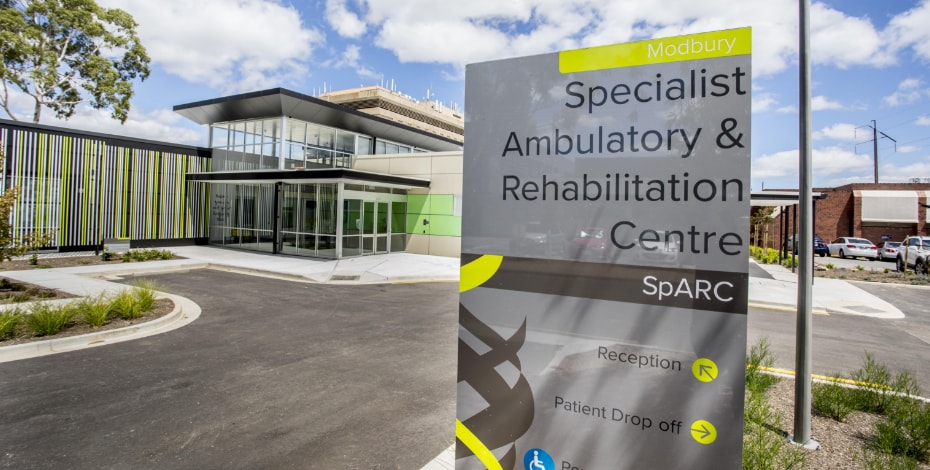
State-of-the-art facility improves care

The upgraded Modbury Hospital.
After threats of closure, the Modbury Hospital underwent a stunning, state-of-the-art multi-million dollar upgrade as part of South Australia’s Transforming Health plan. The hospital now features a modern rehabilitation hub for people living in and around Adelaide’s north and north eastern suburbs, with the advancement of technology lifting the standard of care on offer.
It is a new look and advanced clinical offering, which is in stark contrast to the hospital’s previous infrastructure. Transforming Health’s initial review proposed to have the majority of the region’s rehabilitation services more centrally based within the Central Adelaide Local Health Network at the Hampstead Rehabilitation Centre, rather than at the Northern Adelaide Local Health Network based at Modbury.
After much public backlash, a further review of population growth, site logistics and balance of services in the north eastern region, the decision was made to invest in Modbury, making it a leading player in the provision of health services across the state.
The hospital provides a 24-hour emergency department, and other services such as cardiology, oncology, respiratory medicine, orthopaedics and diagnostic imaging. The expanded rehabilitation hub includes the newly built specialist ambulatory rehabilitation centre (SpARC), which delivers day rehabilitation services and specialist consulting clinics to help improve a person’s ability to be more mobile and participate in daily life. It has also minimised the need for local residents to travel significant distances to access some services, especially ongoing rehabilitation, which was previously predominantly available at Hampstead.
The hub brings together allied health specialists in physiotherapy, occupational therapy, exercise physiology, dietetics, social work, psychology, prosthetics and speech therapists with medical and nursing staff. The multidisciplinary team works with patients across aged care, palliative and rehabilitative areas, with physiotherapists integral to assessment, management, care coordination service delivery and discharge planning to ensure continuity into the community. Services are provided to patients in and out of hospital, or within their home depending on their needs.
The multidisciplinary approach to care means people have immediate access to allied health services, and the installation of new and advanced equipment, such as the portable gantry system and bariatric beds, assists clinicians with the manual handling of patients. It also brings improved communication and collaborative work practices, which is a positive for patients and staff, says Nicole Prideaux, who is the senior clinician and manager of the physiotherapy team at the hospital’s aged care and rehabilitation and palliative care division, which provides most of the services at SpARC.
‘There is a huge value in having the different service options of centre-based care versus home-based care coordinated collaboratively at one site and having the different expertise co-located with a multi-D focus.There is also a multi-faceted focus within physiotherapy, where we can look at the best pathways and patient-centred care for our clients across the region and have that awareness of what services and model of care is most appropriate and available.’
SpARC’s physical spaces have also drawn applause, with its design receiving a commendation in the Master Builders SA Excellence in Construction Awards. Designed to support patients on their path to rehabilitation, SpARC is shaped around three pods of activity: a hydrotherapy pool and two gyms, therapy garden, generic treatment and specialist treatment spaces. It is linked to the rehabilitation ward in the main hospital via a covered walkway. It has large rooms and a home environment setting has been created with the inclusion of communal kitchen and dining areas to assist with daily living rehabilitation training.
The rehabilitation hub facilities, including the revamped wards with more private rooms, are enabling greater numbers of stroke, orthopaedic and amputee patients, as well as those recovering from surgery or other illnesses, to receive care closer to home and to regain their independence so they can return to daily life sooner.
‘It’s a similar structure to the three local health networks that are based in the Adelaide-metro area, and we have integrated newer SA Health initiatives including tele-rehab, where we use this technology to help with any of the physiotherapy education and rehabilitation services to provide extra dosage for our patients,’ Nicole says.
For aged care, physiotherapists are involved in a restorative care model for patients, either in the inpatient ward or within patient’s homes within the community. For inpatient or community palliative care, physiotherapists participate in assessing, managing and providing appropriate referrals or services, while rehabilitation services are offered either through three inpatient wards with 52 beds (up from 20 and used for neurological conditions, geriatric, and amputee and complex orthopaedic needs) in ambulatory services or in the home.
Day rehabilitation, pain management services, falls clinics, and strength and wellness groups provide education and treatment services. Nicole says ‘follow-on’ from the implementation of Transforming Health means there are ongoing opportunities for physiotherapists to deliver improved models of care.
‘It’s exciting professionally to see development of a newer service, there are challenges and there are opportunities that come with that. We have a team that is positive, adaptive and willing to grow and provide services in a fast-paced environment.
‘We are getting a large number of referrals into day rehab, and as clinicians have an increasing awareness of our specialist services and clinics such as pain or falls, we are seeing many opportunities for improved coordination of care and cross referrals for patients with complex and multiple needs. Certainly, the addition of services is filling a gap and the challenge is now ensuring coordinated patient-centred care.
‘It’s a process of continuous improvement of looking at where the gaps are, what the rehab benchmarking is, what is the best evidence based-practice care in those spaces, and hence most appropriate models ofcare for service delivery,’ Nicole says.
‘Overall, it’s an opportunity for more streamlined, more efficient, more effective delivery of services because we are all co-located in the one space … we are not reinventing the wheel but learning about new ways to implement processes and new initiatives.’
© Copyright 2024 by Australian Physiotherapy Association. All rights reserved.





